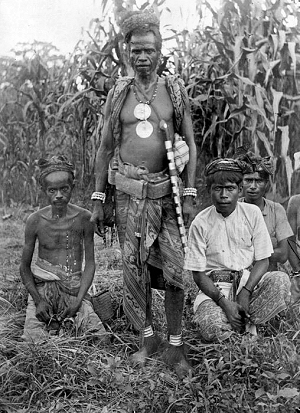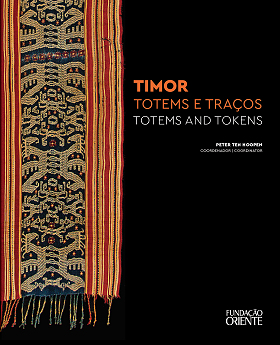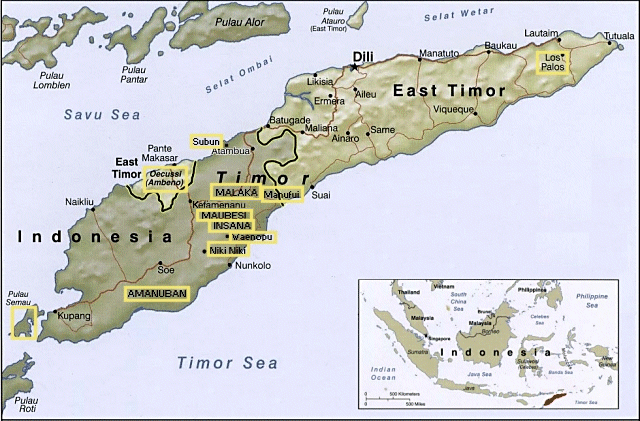 | 
IKAT FROM TIMOR, INDONESIA
GALLERY 

- 002 EAST TIMOR
Beti naek (men's wrap). Warp ikat. Late 19th to early 20th c. . Oecusse/Ambenu, the East-Timorese exclave in West-Timor. Capital Pante Macassar or village in the lower elevations. Atoni people.
- 004 WEST TIMOR
Turban cloth. Warp ikat. 1940-60. Probably made by Atoni people (Atoin meto).
- 005 WEST TIMOR
Mau naek (men's wrap). Warp ikat. 1950-1960. Pusu or Lekat, Amanuban.
- 013 WEST TIMOR
Mau naek (men's wrap). Warp ikat. 19th to early 20th c. Amanuban, largest of the Atoni kingdoms.
- 020 WEST TIMOR
Tais feto (women's sarong). Warp ikat. 19th to early 20th c. Malaka Timur (Belu), Tetun people
- 023 WEST TIMOR
Beti naek (men's wrap). Warp ikat. 1920-1940. Insana or Ambenu
- 031 WEST TIMOR
Tais (sarong). Warp ikat. 1930-1950. Malaka, Tetun people
- 077 EAST TIMOR
Tais (sarong). Warp ikat. Early 20th c. Lospalos, Lautem district, possibly Loré. Fataluku people.
- 081 WEST TIMOR
Beti naek (men's wrap). Warp ikat. 1950-1960. Subun, Western Insana, North Central Timor.
- 086 WEST TIMOR
Beti naek (men's wrap). Warp ikat. Circa 1950. Insana
- 094 WEST TIMOR
Beti naek (men's wrap). Warp ikat. 1940-1955. Insana, most likely Manufui, possibly Manumain B.
- 095 WEST TIMOR
Beti naek (men's wrap). Warp ikat. 1920-1940. Insana, North Central Timor, near Maubesi.
- 112 WEST TIMOR
Mau naek (men's wrap). Warp ikat. Circa 1910. Amanuban, largest of the old Atoni kingdoms.
- 118 EAST TIMOR
Beti naek (men's wrap). Warp ikat. 1930-1950. Oecusse/Ambenu the East-Timorese exclave in West-Timor. Village in the lower elevations. Atoni people.
- 120 WEST TIMOR
Tais mane (men's wrap). Warp ikat. 1930-1940. Waenopu (eastern part of Timor Barat, Belu Regency).
- 121 EAST TIMOR
Sikal-lau (shawl). Warp ikat. Circa 1940. Tutuala, Los Palos, Lautem district, Fataluku people.
- 122 EAST TIMOR
Tais (sarong). Warp ikat. 1940. Tutuala, Los Palos, Lautem district, Fataluku people, Jen i La'i Ratu clan.
- 132 WEST TIMOR
Beti naek (men's wrap). Warp ikat. 1935-1950. Maubesi, a market village between Insana and Kefamenanu.
- 133 WEST TIMOR
Sarong. Warp ikat. Circa 1950. Insana District. Timor Tengah Utara.
- 137 WEST TIMOR
Tais mane (blanket). Warp ikat. Circa 1950. Malaka, Belu Regency, Tetun people
- 149 WEST TIMOR
Beti naek (men's wrap). Warp ikat. 1940-1960. Mamsena, the neighbouring village of Maubesi, in the sub-district of Insana, North Central Timor
- 150 WEST TIMOR
Bete krao (men's wrap). Warp ikat. 1970. Manulea (Malaka Tengah), Atoin Meto people.
- 156 WEST TIMOR
Tais feto (sarong). Warp ikat. Circa 1880. Malaka. The motifs match both the Malaka and the Insana vernacular, but given the morinda end panels it was most likely made by Tetun people on the Malaka side of the border.
- 157 WEST TIMOR
Mau naek (men's wrap). Warp ikat. 19th c. Amanuban: village of Pusu, Lakat, Ofu or Naime hamlet in desa Nule
- 159 WEST TIMOR
Mau naek (men's wrap). Warp ikat. First half of the 20th c. Amanatun, a rather isolated part of Timor Tengah Selatan Regency; Bokong village or the Oinlasi area.
- 162 WEST TIMOR
Blanket. Warp ikat. Circa 1950. Could be Semau, or Kupang region in Western Timor.
- 169 EAST TIMOR
Beti naek (men's wrap)�. Warp ikat. Early 20th century. Oecusse/Ambenu, the East-Timorese exclave in West-Timor. Village in the lower elevations. Atoni people.
- 176 WEST TIMOR
Beti naek (men's wrap). Warp ikat. First half 20th c. Biboki, Insana district, probably Tamkesi area, in the mountainous spine of Timor. Atoin Meto (Atoni) people.
- 177 WEST TIMOR
Beti naek (men's wrap). Warp ikat. Early 20th century. Biboki, Insana district. Atoin Meto (Atoni) people.
- 181 WEST TIMOR
Mau naek (men's wrap). Warp ikat. 1925-1950. Amanuban or Miomafo.
- 182 WEST TIMOR
Beti naek (men's wrap). Warp ikat and supplementary warp. Circa 1950. Miomafo, Biboki, Insana district, probably from area just north of Kefemenanu; Atoin Meto (Atoni) people.
- 183 WEST TIMOR
Tais (sarong). Warp ikat. Late 19th c. Northern Biboki, Insana district, Atoni people
- 186 SEMAU
Seman baklobe (shawl). Warp ikat. Before 1950. Semau Island or Kupang region of West Timor, Helong people
- 189 EAST TIMOR
Beti naek (men's wrap)�. Warp ikat. 1925-1945. Oecusse/Ambenu, the East-Timorese exclave in West-Timor. Unidentified village in the lower elevations, e.g. in Desa Cunha region. Atoni people.
- 191 WEST TIMOR
Tais (sarong). Warp ikat. 1930-1950. Amarasi, Oekabiti clan.
- 192 WEST TIMOR
Mau naek (men's wrap). Warp ikat. 1930-1950. Amarasi, Oekabiti clan.
- 206 WEST TIMOR
Tais (sarong). Warp ikat. 1930-1945. Amarasi, Baun people.
- 207 WEST TIMOR
Tais (sarong). Warp ikat. 1920-1940. Amarasi, Oekabiti clan.
- 208 WEST TIMOR
Tais (sarong). Warp ikat. 1950. Amarasi, Atoin Meto people, Oekabiti clan.
- 215 WEST TIMOR
Tais koli (shroud). Warp ikat. 1930-1945. Tetun people, probably from Malaka, S.E. Western Timor; possibly from Suai Loro or Camenaça, Cova Lima district, across the border in Timor Leste.
- 216 WEST TIMOR
Beti naek (men's wrap). Warp ikat. 1950-1960. Biboki, Insana district.
- 224 WEST TIMOR
Bete krao (blanket). Weft ikat. Late 19th to early 20th c. Manulea (Malaka Tengah), Atoin Meto people
- 235 WEST TIMOR
Fat (blanket). Warp ikat. 19th to early 20th c. Anas region of northern Amanatun, Linome village, Tafuli clan.
- 236 EAST TIMOR
Tais (sarong). Warp ikat. Circa 1920. Suai-Camenaça, Suai-Loro or Camenaça village, Cova Lima District. Tetun people.
- 237 EAST TIMOR
Tais (sarong). Warp ikat. 1935-1950. Suai-Camenaça, Suai-Loro or Camenaça village, Cova Lima District. Tetun people.
- 240 EAST TIMOR
Beti naek (men's wrap)�. Warp ikat. Late 19th to early 20th c. Oecusse/Ambenu, the East-Timorese exclave in West-Timor; Taiboko village, Atoni people
- 244 WEST TIMOR
Mau naek (men's wrap). Warp ikat. Early 20th c. Amanuban, largest of the old Atoni kingdoms, most likely in Niki-Niki
- 245 WEST TIMOR
Mau naek (men's wrap). Warp ikat. 1930-1950. Amanuban
- 256 EAST TIMOR
Beti naek (men's wrap). Warp ikat. 1920-1930. Ambenu (Ocousse), the East-Timorese exclave in West-Timor. Capital Pante Macassar or village in the lower elevations. Atoni people.
- 258 WEST TIMOR
Mau naek (men's wrap). Warp ikat. 1900-1930. Niki-Niki in Amanuban most likely, else Insana
- 282 WEST TIMOR
Beti naek (men's wrap). Warp ikat. 1930-1950. Amanuban
- 285 WEST TIMOR
Tais (sarong). Warp ikat and buna. Early 20th c. Malaka Timur, Tetun people.
- 286 EAST TIMOR
Tais duka (shawl). Warp ikat. 1950 or before. Covalima (Cova Lima), Tetun people.
- 287 WEST TIMOR
Beti naek (men's wrap). Warp ikat. 1920-1945. Insana region, perhaps Ainuit village.
- 289 WEST TIMOR
Mau naek (men's wrap). Warp ikat. 1930-1950. Amanatun
- 291 EAST TIMOR
Tais sabu (men's wrap). Warp ikat. 2017. Bobonaro, Kemak people
- 292 EAST TIMOR
Beti naek (men's wrap). Warp ikat. 1950 or before. Ambenu (Ocusi), the East-Timorese exclave in West-Timor. Village in the lower elevations. Atoni people.
- 293 EAST TIMOR
Tais halai laran (shawl). Warp ikat. 1935-1950. Covalima (Cova Lima), Tetun people.
- 296 WEST TIMOR
Mau'ana (shawl). Warp ikat and buna. Ca. 1950. Molo, else probably Amanuban Barat, more specifically Nusa, where such large motifs were more common than elsewhere in the region
- 297 WEST TIMOR
Mau naek (men's wrap). Warp ikat. ca. 1950. Molo, else probably Amanuban Barat, more specifically Nusa, where such large motifs were more common than elsewhere in the region.
- 298 EAST TIMOR
Tais feto (sarong). Warp ikat. 1910-1930. Viqueque, Tetun people
- 303 WEST TIMOR
Tais mane (men's wrap). Warp ikat. 19th or early 20th c. Probably Tamkesi village in southern Biboki, possibly Ponu in northern Biboki.
- 312 WEST TIMOR
Mau naek (men's wrap). Warp ikat. Early 20th c. Ayotupus region of Amanatun Utara - probably Bokong, close to Sambet where the King has his ancestral home, the heart of Ayotupus
- 324 WEST TIMOR
Bete krao (men's wrap). Warp ikat. 19th to early 20th c. Manulea (Malaka Tengah), Atoin Meto people.
- 325 WEST TIMOR
Mau naek (men's wrap). Warp ikat. 1970. Noebesa village, close to Niki-Niki, North Amanuban
- 326 WEST TIMOR
Mau naek (men's wrap). Warp ikat. Late 19th or early 20th c. Desa Hane, Amanuban Barat
- 327 EAST TIMOR
Tais duka (shawl). Warp ikat. 1920-1930. Suai-Loro
- 328 EAST TIMOR
Tais feto (sarong). Warp ikat. 1920-1940. Suai-Loro
- 329 EAST TIMOR
Tais manu saen (men's wrap). Warp ikat. 1930-1950. Bobonaro, Kemak people
- 330 EAST TIMOR
Tais sela (horse blanket). Warp ikat. 1940s. Suai Loro, Covalima
- 331 EAST TIMOR
Tais altar (altar cloth). Warp ikat. 1940-1950. Suai Loro, Covalima
- 332 WEST TIMOR
Beti naek (men's wrap). Warp ikat. 1950 or before. Pene Utara, Amanuban (neighbouring villages are Hoie and Oineno)
- 335 WEST TIMOR
Mau naek (men's wrap). Warp ikat. Early 20th century. Amanuban: village of Pusu, Lakat, Ofu or Naime hamlet in desa Nule
- 341 EAST TIMOR
Tais sabu (men's wrap). Warp ikat. Circa 1950. Marobo, Bobonaro District
- 349 WEST TIMOR
Mau (men's wrap). Warp ikat. Mid 20th c. Amanatun, most likely Amanatun Utara
- 360 WEST TIMOR
Mau naek (men's wrap). Warp ikat. 1945. Bokong, North Amanatun
- 363 WEST TIMOR
Mau naek (men's wrap). Warp ikat. 1925-1940. Amanuban
- 370 WEST TIMOR
. Warp ikat. 1930-1945. Biboki
Timor Barat and Timor Timur
The name 'Timor', which means 'East' in Malay and related languages ('timur' being the modern spelling), is derived from its location at the eastern extremity of the Lesser Sunda Islands. Politically the island is split in two roughly equal parts, West Timor (bahasa Timor Barat), which is part of the Republic of Indonesia, and East Timur (bahasa Timor Timur), which forms the independent republic of Timor Leste. The two parts of the island had a different colonial past, and a distinct recent history, and have diverged culturally to a fair degree, reasons why we look at the two parts separately. Please refer to our articles on:
- Timor Barat, West Timor, long part of the Dutch East Indies, in 1949 became integrated into the Republic of Indonesia.
- Timor Timur, East Timor, a Portuguese colony until 1975, after struggle with Indonesia in 2002 became independent nation of Timor-Leste.
For a cursory trip across the island you can use the interactive map below to go directly to a page with an ikat textile from a specific region on Timor.
Timor - a world of diversity
Timor is markedly different from the rest of Nusa Tenggara. The range of volcanoes, many of them active, that runs through the Indonesian archipelago from Sumatra on eastwards, after Flores veers north to continue in the Moluccas. Timor is by no means flat though. It has a mountainous interior with seven peaks reaching 2500 - 3000 m, and is geologically an extension of Australia of which it once was a part. Its semi-arid climate is also strongly influenced by Australia, marked by an extremely wet rainy season and a very long dry season know to cause lapar biasa, 'common hunger' - one of the few things that the Timorese can truly be said to have in common, as in many respects they show great diversity, which manifests itself in their textiles.
Only one other island in the Indonesian archipelago (namely Flores) shows more diversity in ikat patterning than Timor, a mountainous island about 500 km long with over twenty different languages. Archaeological finds suggest that Timor was settled by Homo erectus, an early hominoid related to Java Man as early as a million years ago. It received waves of immigration for thousands of years, first by Austro-Melanesians and in the period of 3000 to 1000 BC by Austronesians from Taiwan, who brought with them emblematic practices such as animist beliefs, headhunting, tattooing, the use of barkcloth, agriculture and domestication of animals - mainly pigs and dogs, both of which were on the menu.
|
|

|

|
|
Atoni warriors wearing ikat waistcloths, that appear to indicate Ambenu provenance. [Note the similarity with our PC 169] Early 20th C. Photographer unknown. Collection Tropenmuseum, GPL.
|
Highland dwellers
Whereas on most islands in the Indonesian archipelago the population is concentrated in coast towns and villages, remarkably, most of the Timorese, especially those of the dominant Atoni stock, prefer the highlands of the interior. Villages were traditionally small to very small, most Timorese preferring to live well away from others who might compete for land use. Many hamlets were built on precarious, hardly accessible locations, that offered protection from slave traders and other enemies.
Shortly before and after the influx of the Austronesians the island appears to have received waves of Papuan speaking groups. In the period between 1500 and 100 BC There may also have been cultural influences from the Lapita culture of Melanesia and Western Polynesia. A millennium later, between 500 and 100 BC, the North Vietnamese Dong-Son bronze making culture dominated large swaths of the Indonesian archipelago, bringing social stratification, rice cultivation and handicrafts. Many authors mention weaving with the backstrap loom as a Dong-Son legacy, but it is well established by now that weaving came to the Indonesian archipelago thousands of years before. Though the Dongsong culture left many traces on nearby Alor, including finely decorated bronze kettle drums or moko, it is likely to have influenced Timorese only to a limited extent, due to both its peripheral position and its climate, with its long dry period, which allows only one rice crop per year.
In the first seven centuries AD the Indianized Buddhist and Hindu kingdoms on Sumatra and Java must have made a cultural impact, though again, only to a limited extent due to Timor's remote position. The same applies to the Islamic influences exerted from the 13th C. onwards by the sultanates of the nearby Moluccas, which were attenuated not just by geography, but from 1520 onwards also by the Portuguese and Dutch colonial masters who fought over the island for centuries, but agreed on one thing: they preferred their subjects Christian, and encouraged migration to Timor of converted peoples whom they considered loyal subjects. These included so-called Topasses, people of mixed Portuguese and Asian blood, many from Eastern Flores.
The Dutch, who took control of the western portion of Timor in 1613, also shipped over Rotinese, from the small island just west of the western tip of Timor, and Savunese from a tiny island in the Savu Sea further west. The Rotinese and Savunese had been Christianized by the Dutch early in the 17th C., and due to competition between the local nobles as to who could build the better schools, received a solid education that made them ideal civil servants. For several centuries they were the de facto shapers of Timorese society.
Identity remains locally rooted
Timor has long been on the trading map, originally because of its fabled sandalwood (which diminished sharply in the 1920s due to over-harvesting) and beeswax, later also because of its indigo which the Dutch forced the islanders to cultivate for export to India and other Asian lands. As a result, the ports of Kupang in West Timor and Dili in East Timor have always received an influx of foreign traders, such as Arabs, Chinese, Buginese and Macassans, who further enriched the cultural mix that is Timor. There is also a strong Papuan influence, especially in East Timor.
Most of the Timorese still speak their local language, but are also fluent in Bahasa Indonesia (in the West) or Portuguese (in the East). Due to the cultural diversity and the rough terrain which has always limited communication, there has never existed a 'Timorese' identity. Most Timorese still identify themselves by historical origin: the old kingdom they hail from, and their clan background - which even today are immediately identifiable by the textiles they wear. Unfortunately nearly all ikat made on Timor today relies heavily on the chemical industry. Traders who scour the island for 'full asli' ikat, nagging the old people to surrender their last remaining adat pieces, report coming up dry on most of their trips and may soon give up.
|
Literature
Apart from the excellent works by Yeager & Jacobson and Hamilton & Barrkman mentioned in the Literature sections you may want to consider acquiring Peter ten Hoopen, ed., Timor: Totems and Tokens, which appeared in 2019. It gives an overview of different styles of ikat on Timor, using almost exclusively early examples, and is particularly strong on East Timor.
 |
|
Timor: Totems and Tokens, the catalogue of the eponymous exhibition at Lisbon's Museu do Oriente in 2019-2020, introduces the ikat from both West Timor (Indonesia) and East Timor (Timor-Leste). Edited by Peter ten Hoopen, with contributions by Jill Forshee, Linda S. McIntosh, Pierre Dugard and Georges Breguet.
Illustrated with field photography both contemporary and historic, and 70 full page plates. Bilingual: English and Portuguese. Size: 23x28 cm, 192 pages. Published by Fundação Oriente, Lisbon.

|
Map of Timor - Interactive (number of active links to be extended)
Click on marked areas to jump to one particular example from the respective village or region. Note that there may be more specimens from the same region, but the link will go to just one example.

©Peter ten Hoopen, 2025. The contents of this website are provided for personal, educational, non-commercial use only.
No part of this website may be reproduced in any form without explicit permission of the copyright holder.
|  |





